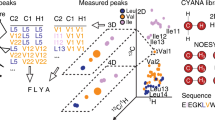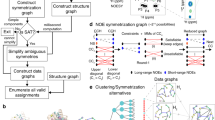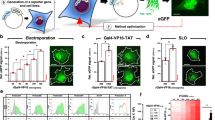Abstract
Nuclear-magnetic-resonance spectroscopy can determine the three-dimensional structure of proteins in solution. However, its potential has been limited by the difficulty of interpreting NMR spectra in the presence of broadened and overlapping resonance lines and low signal-to-noise ratios. Here we present stereo-array isotope labelling (SAIL), a technique that can overcome many of these problems by applying a complete stereospecific and regiospecific pattern of stable isotopes that is optimal with regard to the quality and information content of the resulting NMR spectra. SAIL uses exclusively chemically and enzymatically synthesized amino acids for cell-free protein expression. We demonstrate for the 17-kDa protein calmodulin and the 41-kDa maltodextrin-binding protein that SAIL offers sharpened lines, spectral simplification without loss of information, and the ability to rapidly collect the structural restraints required to solve a high-quality solution structure for proteins twice as large as commonly solved by NMR. It thus makes a large class of proteins newly accessible to detailed solution structure determination.
This is a preview of subscription content, access via your institution
Access options
Subscribe to this journal
Receive 51 print issues and online access
$199.00 per year
only $3.90 per issue
Buy this article
- Purchase on Springer Link
- Instant access to full article PDF
Prices may be subject to local taxes which are calculated during checkout




Similar content being viewed by others
References
Kennedy, M. A., Montelione, G. T., Arrowsmith, C. H. & Markley, J. L. Role for NMR in structural genomics. J. Struct. Funct. Genom. 2, 155–169 (2002)
Clore, G. M. & Gronenborn, A. M. Structures of larger proteins, protein–ligand and protein–DNA complexes by multidimensional heteronuclear NMR. Prog. Biophys. Mol. Biol. 62, 153–184 (1994)
Clore, G. M. & Gronenborn, A. M. NMR structure determination of proteins and protein complexes larger than 20 kDa. Curr. Opin. Chem. Biol. 2, 564–570 (1998)
Gardner, K. H. & Kay, L. E. The use of 2H, 13C, 15N multidimensional NMR to study the structure and dynamics of proteins. Annu. Rev. Biophys. Biomol. Struct. 27, 357–406 (1998)
Goto, N. K. & Kay, L. E. New developments in isotope labeling strategies for protein solution NMR spectroscopy. Curr. Opin. Struct. Biol. 10, 585–592 (2000)
Pervushin, K., Riek, R., Wider, G. & Wüthrich, K. Attenuated T2 relaxation by mutual cancellation of dipole–dipole coupling and chemical shift anisotropy indicates an avenue to NMR structures of very large biological macromolecules in solution. Proc. Natl Acad. Sci. USA 94, 12366–12371 (1997)
Mueller, G. A. et al. Global folds of proteins with low densities of NOEs using residual dipolar couplings: Application to the 370-residue maltodextrin-binding protein. J. Mol. Biol. 300, 197–212 (2000)
Markley, J. L., Putter, I. & Jardetzky, O. High-resolution nuclear magnetic resonance spectra of selectively deuterated staphylococcal nuclease. Science 161, 1249–1251 (1968)
LeMaster, D. M. Chiral β and random fractional deuteration for the determination of protein side-chain conformation by NMR. FEBS Lett. 223, 191–196 (1987)
Farmer, B. T. II & Venters, R. A. NMR of perdeuterated large proteins. Mod. Techniques Protein NMR 16, 75–120 (1999)
Arata, Y., Kato, K., Takahashi, H. & Shimada, I. Nuclear-magnetic-resonance study of antibodies—a multinuclear approach. Methods Enzymol. 239, 440–464 (1994)
Yamazaki, T. et al. Segmental isotope labeling for protein NMR using peptide splicing. J. Am. Chem. Soc. 120, 5591–5592 (1998)
Oba, M., Kobayashi, M., Oikawa, F., Nishiyama, K. & Kainosho, M. Synthesis of 13C/D doubly labelled l-leucines: Probes for conformational analysis of the leucine side-chain. J. Org. Chem. 66, 5919–5922 (2001)
Oba, M., Terauchi, T., Miyakawa, A., Kamo, H. & Nishiyama, K. Stereoselective deuterium-labelling of diastereotopic methyl and methylene protons of l-leucine. Tetrahedron Lett. 39, 1595–1598 (1998)
Oba, M., Terauchi, T., Miyakawa, A. & Nishiyama, K. Asymmetric synthesis of l-proline regio- and stereoselectively labelled with deuterium. Tetrahedron Asymmetry 10, 937–945 (1999)
Torizawa, T., Shimizu, M., Taoka, M., Miyano, H. & Kainosho, M. Efficient production of isotopically labelled proteins by cell-free synthesis: A practical protocol. J. Biomol. NMR 30, 311–325 (2004)
Kigawa, T., Muto, Y. & Yokoyama, S. Cell-free synthesis and amino acid-selective stable-isotope labeling of proteins for NMR analysis. J. Biomol. NMR 6, 129–134 (1995)
Zubay, G. In-vitro synthesis of protein in microbial systems. Annu. Rev. Genet. 7, 267–287 (1973)
McIntosh, L. P. & Dahlquist, F. W. Biosynthetic incorporation of 15N and 13C for assignment and interpretation of nuclear-magnetic-resonance spectra of proteins. Q. Rev. Biophys. 23, 1–38 (1990)
Kay, L. E., Nicholson, L. K., Delaglio, F., Bax, A. & Torchia, D. A. Pulse sequences for removal of the effects of cross-correlation between dipolar and chemical-shift anisotropy relaxation mechanism on the measurement of heteronuclear T1 and T2 values in proteins. J. Magn. Reson. 97, 359–375 (1992)
Vuister, G. W. & Bax, A. Resolution enhancement and spectral editing of uniformly 13C-enriched proteins by homonuclear broadband 13C decoupling. J. Magn. Reson. 98, 428–435 (1992)
Güntert, P., Braun, W., Billeter, M. & Wüthrich, K. Automated stereospecific 1H NMR assignments and their impact on the precision of protein structure determinations in solution. J. Am. Chem. Soc. 111, 3997–4004 (1989)
Nilges, M., Clore, G. M. & Gronenborn, A. M. 1H-NMR stereospecific assignments by conformational data-base searches. Biopolymers 29, 813–822 (1990)
Neri, D., Szyperski, T., Otting, G., Senn, H. & Wüthrich, K. Stereospecific nuclear magnetic resonance assignments of the methyl groups of valine and leucine in the DNA-binding domain of the 434 repressor by biosynthetically directed fractional 13C labeling. Biochemistry 28, 7510–7516 (1989)
Cavanagh, J., Palmer, A. G., Fairbrother, W. & Skelton, N. Protein NMR Spectroscopy: Principles and Practice (Academic, San Diego, 1996)
Torizawa, T., Ono, M. A., Terauchi, T. & Kainosho, M. NMR assignment methods for the aromatic ring resonances of phenylalanine and tyrosine residues in proteins. J. Am. Chem. Soc. 127, 12620–12626 (2005)
Sharff, A. J., Rodseth, L. E. & Quiocho, F. A. Refined 1.8-Å structure reveals the mode of binding of β-cyclodextrin to the maltodextrin binding protein. Biochemistry 8, 10553–10559 (1993)
Marion, D., Kay, L. E., Sparks, S. W., Torchia, D. A. & Bax, A. 3-dimensional heteronuclear NMR of 15N-labelled proteins. J. Am. Chem. Soc. 111, 1515–1517 (1989)
Güntert, P. Automated NMR protein structure calculation. Prog. NMR Spectrosc. 43, 105–125 (2003)
Herrmann, T., Güntert, P. & Wüthrich, K. Protein NMR structure determination with automated NOE assignment using the new software CANDID and the torsion angle dynamics algorithm DYANA. J. Mol. Biol. 319, 209–227 (2002)
Chattopadhyaya, R., Meador, W. E., Means, A. R. & Quiocho, F. A. Calmodulin structure refined at 1.7 Å resolution. J. Mol. Biol. 228, 1177–1192 (1992)
Chou, J. J., Li, S., Klee, C. B. & Bax, A. Solution structure of Ca2+-calmodulin reveals flexible hand-like properties of its domains. Nature Struct. Biol. 8, 990–997 (2001)
Güntert, P., Mumenthaler, C. & Wüthrich, K. Torsion angle dynamics for NMR structure calculation with the new program Dyana. J. Mol. Biol. 273, 283–298 (1997)
Cornilescu, G., Delaglio, F. & Bax, A. Protein backbone angle restraints from searching a database for chemical shift and sequence homology. J. Biomol. NMR 13, 289–302 (1999)
Cornell, W. D. et al. A second generation force field for the simulation of proteins, nucleic acids, and organic molecules. J. Am. Chem. Soc. 117, 5179–5197 (1995)
Koradi, R., Billeter, M. & Güntert, P. Point-centered domain decomposition for parallel molecular dynamics simulation. Comput. Phys. Commun. 124, 139–147 (2000)
Ikura, M. et al. Secondary structure and side-chain 1H and 13C resonance assignments of calmodulin in solution by heteronuclear multidimensional NMR spectroscopy. Biochemistry 30, 9216–9228 (1991)
Acknowledgements
We thank M. Ikura and T. Yamazaki for providing the calmodulin and maltodextrin-binding protein genes, respectively, and M. Takeda for help with the preparation of figures. This work was supported by CREST/JST.
Author information
Authors and Affiliations
Corresponding author
Ethics declarations
Competing interests
Atomic coordinates of the SAIL-CaM and SAIL-MBP structures have been deposited in the Protein Data Bank with accession codes 1X02 and 2D21, respectively. Chemical shifts have been deposited in the BioMagResBank with accession numbers 6541 and 6807. Reprints and permissions information is available at npg.nature.com/reprintsandpermissions. The authors declare no competing financial interests.
Supplementary information
Supplementary Notes
This file contains Supplementary Figure 1, which shows the isotope labelling patterns of the 20 SAIL amino acids. This file also contains Supplementary Table 1, which affords NMR structure statistics for SAIL–CaM and SAIL–MBP. (PDF 72 kb)
Rights and permissions
About this article
Cite this article
Kainosho, M., Torizawa, T., Iwashita, Y. et al. Optimal isotope labelling for NMR protein structure determinations. Nature 440, 52–57 (2006). https://doi.org/10.1038/nature04525
Received:
Accepted:
Issue Date:
DOI: https://doi.org/10.1038/nature04525
This article is cited by
-
E. coli “Stablelabel” S30 lysate for optimized cell-free NMR sample preparation
Journal of Biomolecular NMR (2023)
-
Effect of C deuteration in forming isotopic polymorph of glycine silver nitrate
Structural Chemistry (2023)
-
Measurement of 1Hα transverse relaxation rates in proteins: application to solvent PREs
Journal of Biomolecular NMR (2022)
-
Chemical shift assignments of calmodulin under standard conditions at neutral pH
Biomolecular NMR Assignments (2022)
-
Chemical shift assignments of calmodulin bound to the β-subunit of a retinal cyclic nucleotide-gated channel (CNGB1)
Biomolecular NMR Assignments (2022)
Comments
By submitting a comment you agree to abide by our Terms and Community Guidelines. If you find something abusive or that does not comply with our terms or guidelines please flag it as inappropriate.



